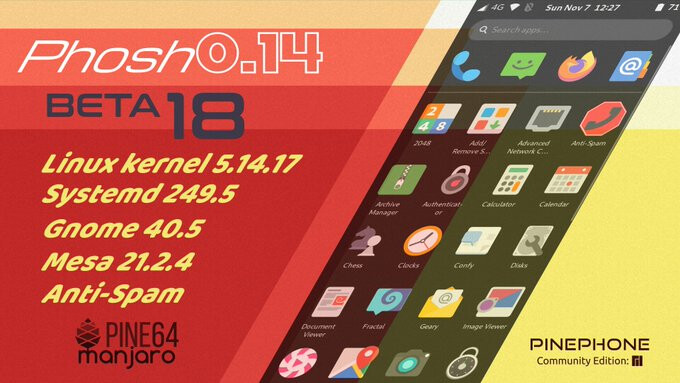Manjaro ARM Beta18 of Phosh for PinePhone!
The Manjaro ARM project is proud to announce our eightteenth BETA release for the PinePhone running Phosh!

This image is running the 5.14 kernel from Megi, which is designed for the PinePhone.
Features:
- Firefox uses a dedicated configuration and plays videos on Youtube pretty well
- Camera app with access to back and front camera, including autofocus
- Auto-Rotate function and manual rotate
- Welcome wizard for easy setup of the device
- We have now a working Torch in the quick-access-menu
- Prime phone functions working, including resume from deep-sleep and free speaking
- Recording of audio works
- Most applications got added to
scale-to-fit - Haptic feedback functions are given
- Optimized keyboard layout for terminal
- Maps working with geolocate
- Volume buttons working
- Sensors fully functional
- Easy access to Bluetooth, Wlan, Rotate and Mobile functions via quick settings
- Default branch is
arm-stable. This can be changed by editing/etc/pacman-mirrors.conf - usage of callaudiod for better audio experience with calls
- This image uses a Crust enabled uboot
Changes since Beta17
- Kernel is now at 5.14.15.
- Phosh is now at 0.14.0
-
Phoc got updated to 0.9.0. If you use
scale-to-fityou may need to update your configs as the app-id handling had changed. - Calls got more SIP enhancements
- Chatty got more enhanced with MMS support
- feedbackd is now more flexible to load custom sound patterns
- Mesa is now at 21.2.4
- mmsd-tng and vvm saw new stable releases
- Pamac 10.2.2 adds some needed AUR fixes
- Powersupply and PostmarketOS Tweaks had some updates
- Systemd is now at 249.5
- pipewire got updated to 0.3.39
- Gnome-Control-Center got updated to 41.0
- Gnome-Calendar got some more adaptive patches added
- Phosh-Antispam is now at 2.0 and provides a nice UI
- regular upstream package updates and cleanups
A detailed list of package changes can be found here.
Currently broken:
- GPS may not work as it should
Known issues
-
Chatty may crash with experimental features like MMS enabled. You may disable them via
gsettings set sm.puri.Chatty experimental-features falseif that is the case - UI becomes unresponsive after a while.
- Doing a recording may result in noisy audio savings
- Lots of apps are still missing or are not mobile friendly yet.
Download:
About the device:
PinePhone:
Perhaps you’re in a line of work where security is a must, or a hard-core Linux enthusiast, or perhaps you’ve just got enough of Android and iOS and you’re ready for something else – the PinePhone may be the next Phone for you. Powered by the same Quad-Core ARM Cortex A53 64-Bit SOC used in our popular PINE A64 Single Board Computer, the PinePhone runs mainline Linux as well as anything else you’ll get it to run.
The purpose of the PinePhone isn’t only to deliver a functioning Linux phone to end-users, but also to actively create a market for such a device, as well as to support existing and well established Linux-on-Phone projects. All major Linux Phone-oriented projects, as well as other FOSS OS’, are represented on the PinePhone and developers work together on our platform to bring support this this community driven device.
Order
Pinephones Beta Edition are still on stock. Visit the Pine64 Store
How to install:
Download the image/xz file from the download location. Verify that the download completed successfully.
After that, install Etcher (sudo pacman -S etcher if on Manjaro) and burn the to an SD card (8 GB or larger).
The PinePhone should recognize the SD card as a bootable device and boot from it.
The premade users are:
User: manjaro
Password: 123456
User: root
password: root
Donate!
Please consider supporting Manjaro ARM directly via Patreon, Ko-Fi or Open Collective.
You can also donate to our upstream, which is Arch Linux ARM.
Bugtracker
If you face issues with this editon, please open a new issue on our bug-tracker
Development Changelog
We will list our progress to Beta19 here
- Beta18 (2021-11-08) Download
- based on stable branch
- Dev (2021-11-14) Download
- based on unstable branch
- Kernel got updated to 5.15.2
- eg25-manager will now break before overflow when receiving messages
- Firefox got updated to 94.0.1
- Most Gnome apps and tools got updated to 41
- Pipewire is now at 0.3.40
- Pamac got renewed to 10.3.0
- We are using now regular rtl8723bt-firmware for Bluetooth. Please switch to that package if you lost Bluetooth support on your end.
- Systemd is now bumped to 249.6
- We are now shipping with the latest Xorg-Server 21.1.1 and XWayland 21.1.3
- Dev (2021-11-29) Download
- based on unstable branch
- Kernel got updated to 5.15.5
- We worked on getting USB Tethering working again
- Chatty is now at 0.5-beta
- We had the regular ICU 70.1 rebuilds
- eg25-manager supports now also the Pinephone Pro
- Firefox is now at 94.0.2
- We fixed some issues with gnome-keyring
- megapixels got updated to 1.4.2
- mesa is at 21.2.5
- ModemManager got updated to 1.18.4
- Phosh got a lot of polish
- We added some more fixes to Squeekboard
- Systemd is now at 249.7
